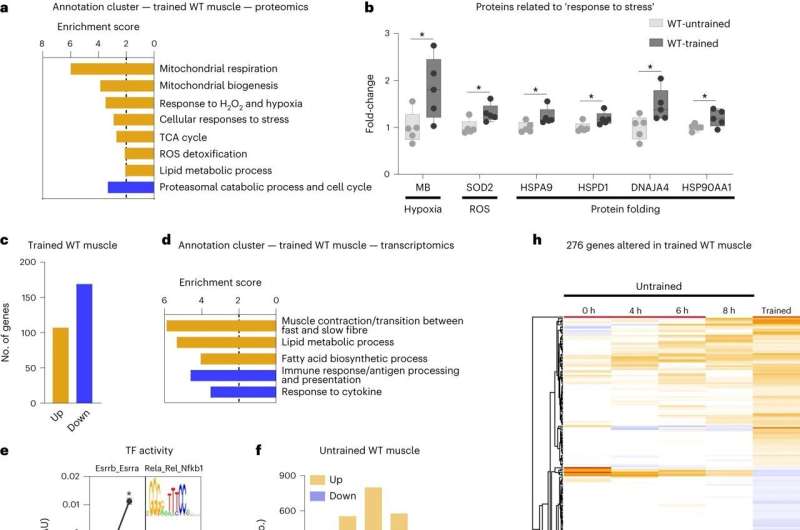This article has been reviewed according to Science X's editorial process and policies. Editors have highlighted the following attributes while ensuring the content's credibility:
fact-checked
peer-reviewed publication
trusted source
proofread
Novel insights into how muscles change during endurance training

The more we exercise our endurance, the fitter we become—and so do our muscles. They adapt to the load and are able to perform better for a longer period of time. A research team at the University of Basel has now uncovered fresh insights into these muscle adaptations through experiments conducted on mice.
Endurance training is beneficial. Regular workouts not only improve physical fitness and well-being, but also trigger profound muscle remodeling. This is reflected in typical training effects: muscles fatigue less quickly, provide more energy, and use oxygen more efficiently.
"The adaptation of muscles to physical activity is a well-acknowledged phenomenon," says Prof. Christoph Handschin, who has long been researching muscle biology at the Biozentrum of the University of Basel. "We wanted to understand what exactly happens in the muscle during exercise training." He and his team have now published new insights in Nature Metabolism.
Training state is reflected in genes
In the current study, Handschin's team compared muscles of untrained with those of trained mice and investigated how gene expression changes in response to exercises. "Since endurance training induces substantial muscle remodeling, we assumed that the adaptations would be reflected in gene expression," says first author Regula Furrer.
"However, in contrast to our expectations, the expression of relatively few, about 250 genes, was changed in resting trained compared to resting untrained muscles. Strikingly, about 1,800 to 2,500 genes were regulated after an acute bout of exercise. How many and which genes respond largely depends on the training state."
Muscles respond differently to physical stress
In untrained muscles, for example, endurance training activates inflammatory genes, triggered by tiny injuries causing what we know as muscle soreness.
"We couldn't observe this in trained mice; instead, genes that protect the muscle are more active. Thus, trained muscles respond completely different to exercise stress," explains Furrer. "They are more efficient and resilient—in short, they can cope better with the physical load."
Epigenetic pattern shapes muscle fitness
The question is: How is it possible that muscles respond so differently to endurance exercise depending on their training state? The scientists found an answer in epigenetics.
Genes are turned on or off by so-called epigenetic modifications, chemical tags in the genome. "It was astonishing that the epigenetic pattern between untrained and trained muscles is totally different and that many of these modifications occur in key genes that control the expression of numerous other genes," emphasizes Furrer. Hence, exercise activates a completely different program in trained compared to untrained muscles.
This epigenetic information determines how the muscle responds to training. "Chronic endurance training alters the epigenetic pattern in the muscle, both in the short- and long-term. It seems that trained muscles are primed for prolonged workouts by their epigenetic pattern. They respond much faster and work more efficiently," summarizes Handschin. "With each training session, muscle endurance increases."

From mouse to human
The researchers revealed how muscles adapt to regular endurance training over time in mice. The next step is to find out whether these results can also be transferred to humans. In competitive sports, biomarkers reflecting training progress could be used to improve the efficiency of the training.
More importantly, "understanding how a healthy muscle works enables us to comprehend what goes wrong in diseases," says Handschin. This is crucial for unlocking innovative avenues for the treatment of age- or disease-related muscle wasting.
More information: Regula Furrer et al, Molecular control of endurance training adaptation in male mouse skeletal muscle, Nature Metabolism (2023). DOI: 10.1038/s42255-023-00891-y





















